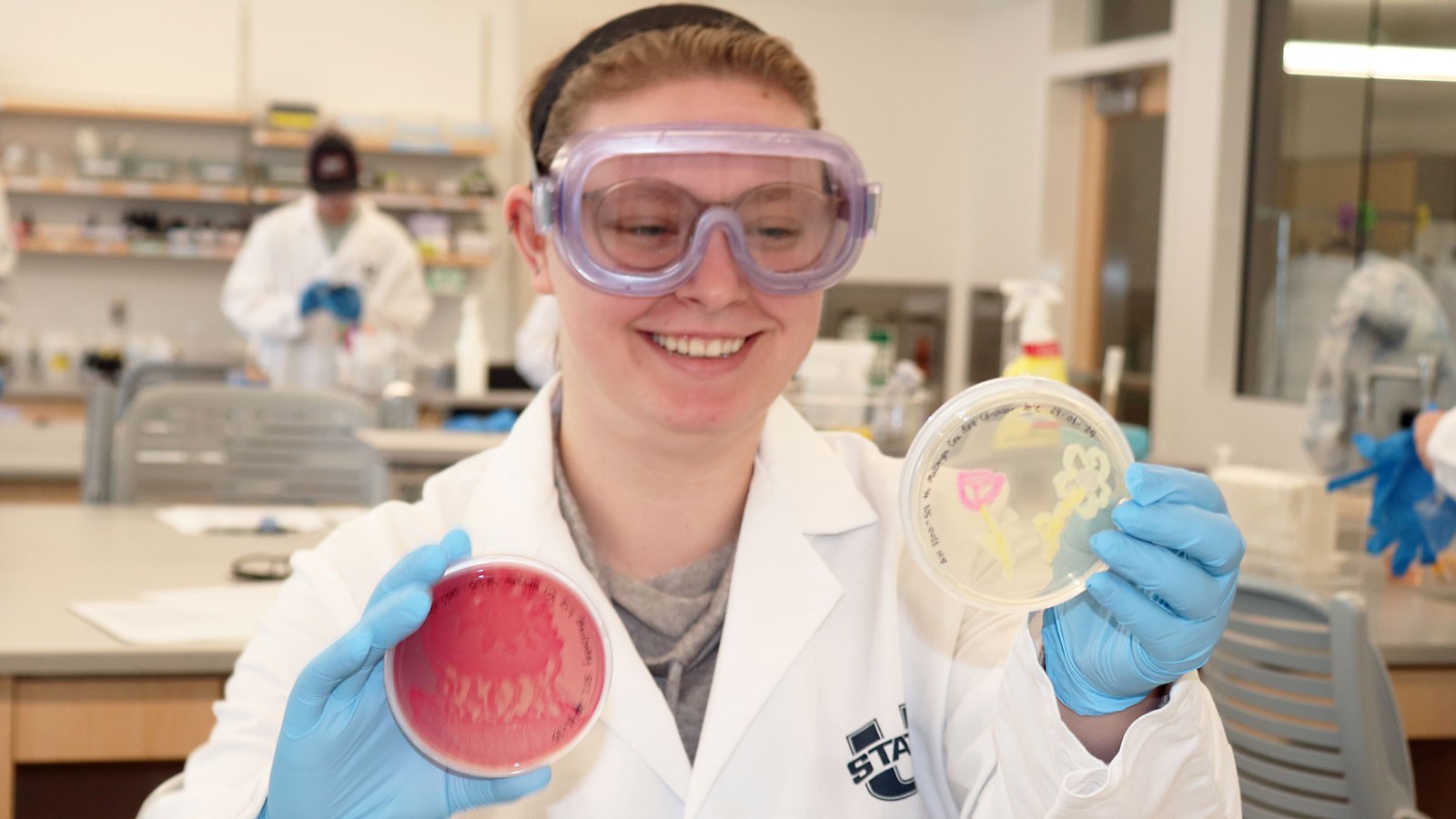Agar Art: USU Microbiology Scholars Flex Their Creativity While Honing Essential Laboratory Skills
Undergraduates in Utah State's Schaeffer/Weinstein Labs craft works of art from colorful bacteria.
By Mary-Ann Muffoletto |
USU microbiology student Makayla Cox displays agar art she created during a BIOL 3300 lab course. Biology faculty member Robert Schaeffer says the creative exercise helps students learn essential lab techniques. (Photo Credit: USU/M. Muffoletto)
A fanciful octopus. A whimsical unicorn. A proud Aggie bull. Is there beauty in pathogens?
Utah State University microbiologist Robert Schaeffer and his students respond with a resounding yes. The Department of Biology faculty member, with colleagues Sara Weinstein and Mitzi Christensen, incorporates “agar art,” a creative exercise to help students master essential laboratory procedures, into the department’s BIOL 3300 General Microbiology lab sections.
Schaeffer says he, with Weinstein and Christensen, developed the activity as way of making learning more engaging.
“Aseptic technique is a collection of required procedures and practices microbiology students must follow to conduct research in the field of microbiology,” says Schaeffer, assistant professor. “The technique prevents the introduction of unwanted microbes into a pure culture or the laboratory environment.”
These procedures, he says, not only help to ensure worker safety but also maintain untainted cultures of microbes for study. Which is the crux of what microbiologists do: They study microorganisms such as bacteria, viruses, algae, fungi and some types of parasites. Studying little organisms often begins with growing specimens in a petri dish filled with agar, a gooey, seaweed-based culture medium that fuels microorganism growth and reproduction.
“In the lab, we use clear, shallow, round dishes, with a cover, called Petri dishes,” Schaeffer says. “We pour a small amount of agar into the dish, cover it to avoid contamination and allow the agar to solidify.”
When the agar is ready, microbiologists, wearing protective gloves and other personal protective equipment, use a wire tool called an inoculation loop to introduce a microorganism, such as a bacterium, onto the agar.
“There are sets of protocols for how microorganisms should be transferred to the growing medium,” Schaeffer says. “These prevent spread of pathogens and the contamination of a sample, and thus allow successful experimentation. Preparing a sample requires strict attention to detail. So, why not make learning this process an enjoyable, creative activity as well?”
Creating art while growing cultures isn’t a new idea. Scottish physician-scientist Alexander Fleming, who discovered the antibiotic properties of penicillin in 1928, created intricate images using live organisms. But widespread practice of agar art, particularly among students, has picked up momentum in the last few years. In fact, the American Society of Microbiology initiated the annual ASM Agar Art Contest in 2015.
“We hope we can continue to develop this exercise with students and, eventually, foster student bacterial paintings that can be submitted to the ASM Agar Art Contest,” Schaeffer says.
For now, Schaeffer’s students are enjoying the opportunities to flex their creative juices, while mastering lab techniques they’ll use repeatedly as they progress in their chosen fields.
“Making art has been fun,” says Dharla Soteros, an undergraduate Animal and Dairy Science major. “We’re combining art with science and learning new techniques at the same time.”
Undergraduate biochemistry major Brad Finley, who fashioned an Aggie Bull mascot from bacteria, says creating agar art is a “fun takeaway” from lab work.
“It’s definitely an interesting way to learn laboratory skills,” he says.
USU Biology doctoral student instructor Mary-Kate Williams, top center, guides microbiology students in correct aseptic technique, a set of procedures and processes designed to ensure lab safety and purity of lab samples. (Photo Credit: USU/M. Muffoletto)
WRITER
Mary-Ann Muffoletto
Public Relations Specialist
College of Science
435-797-3517
maryann.muffoletto@usu.edu
CONTACT
Robert Schaeffer
Assistant Professor
Department of Biology
435-797-0442
robert.schaeffer@usu.edu
TOPICS
Biology 165stories STEM 163stories Teaching 152storiesComments and questions regarding this article may be directed to the contact person listed on this page.









